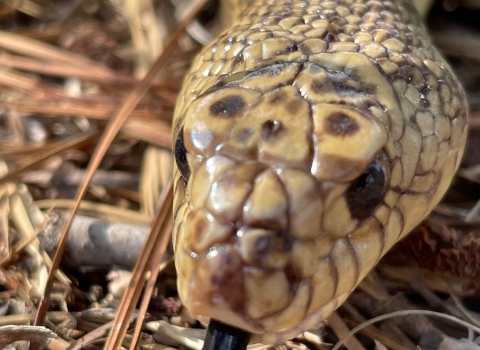Based on the best available science, the U.S. Fish and Wildlife Service is proposing to designate critical habitat for the Louisiana pinesnake, an egg-laying, non-venomous constrictor of western and central Louisiana and eastern Texas that is listed as threatened under the Endangered Species Act (ESA).
When a species is listed under the ESA, the Service is required, where possible, to identify areas known as critical habitat that are essential to the conservation of the species. Critical habitat is being proposed for six units in Bienville, Grant, Rapides and Vernon parishes in Louisiana and Angelina, Jasper and Newton counties in Texas.
Out of a total of 209,520 acres, 72% of the proposed designation is currently occupied by the Louisiana pinesnake. Unoccupied areas proposed as critical habitat are within the snake’s historic range. The occupied and unoccupied areas proposed for critical habitat are essential for the recovery of the species.
Louisiana pinesnakes are generally found in sandy, well-drained soils and open pine forests such as longleaf-pine savanna. The species relies on Baird’s pocket gophers that not only create the burrow systems where the Louisiana pinesnakes are most frequently found but also serve as a major source of food for the snake.
Most of the longleaf pine savanna habitat across the southeastern United States had been reduced by the 1930s, and it rarely regenerated naturally. The remaining natural longleaf pine ecosystem across the species’ range is fragmented and greatly reduced from its historic extent.
During the development of the proposal, the Service worked closely with federal and state partners within the range of the species. The Service received comments from the U.S. Army concerning the potential impact of designating critical habitat on operations on Fort Polk and Peason Ridge. The Service met with the post leadership and provided information on the designation process, including exemptions and exclusions.
State partners within the snake’s historic range are the Texas Parks and Wildlife Department and the Louisiana Department of Wildlife and Fisheries. Both, along with the Natural Resources Conservation Service and the Association of Zoos & Aquariums, previously identified areas with the best potential to become suitable habitat for the Louisiana pinesnake. All lands identified in the proposed critical habitat fall within habitat units they identified.
In addition, as required by the ESA, the Service assessed the economic impacts of this proposed critical habitat designation. The draft economic analysis indicates that economic and other impacts of the critical habitat designation are not likely to be significant, and they will be outweighed by the benefits of the designation.
Critical habitat designation requires federal agencies to ensure that actions they plan to undertake, fund or authorize do not destroy or adversely modify that habitat. It does not establish a wildlife refuge, allow the government or public to access private lands, or require non-federal landowners to restore habitat or recover species.
The Service intends that any final action resulting from this proposed rule will be based on the best scientific data available. Therefore, we request comments or information from other concerned governmental agencies, Native American Tribes, the scientific community, industry or any other interested parties concerning this proposed rule.
For directions on how to submit comments, visit the Federal eRulemaking Portal at http://www.regulations.gov. In the Search box, enter FWS-R4-ES-2021-0166, which is the docket number for this rulemaking. Comments must be received by December 5, 2022. We must receive requests for a public hearing, in writing, at the address shown below by November 21, 2022.
FOR FURTHER INFORMATION CONTACT: Brigette Firmin, Deputy Field Supervisor, U.S. Fish and Wildlife Service, Louisiana Ecological Services Field Office, 200 Dulles Drive, Lafayette, LA 70506; telephone 337-291-3100.
For more information on this proposal, please visit our Frequently Asked Questions.
The mission of the U.S. Fish and Wildlife Service is working with others to conserve, protect, and enhance fish, wildlife, plants, and their habitats for the continuing benefit of the American people. For more information on our work and the people who make it happen, visit www.fws.gov. Connect with our Facebook page at www.facebook.com/usfwssoutheast, follow our tweets at www.twitter.com/usfwssoutheast, watch our YouTube channel at http://www.youtube.com/usfws, and download photos from our Flickr page at http://www.flickr.com/photos/usfwssoutheast.



